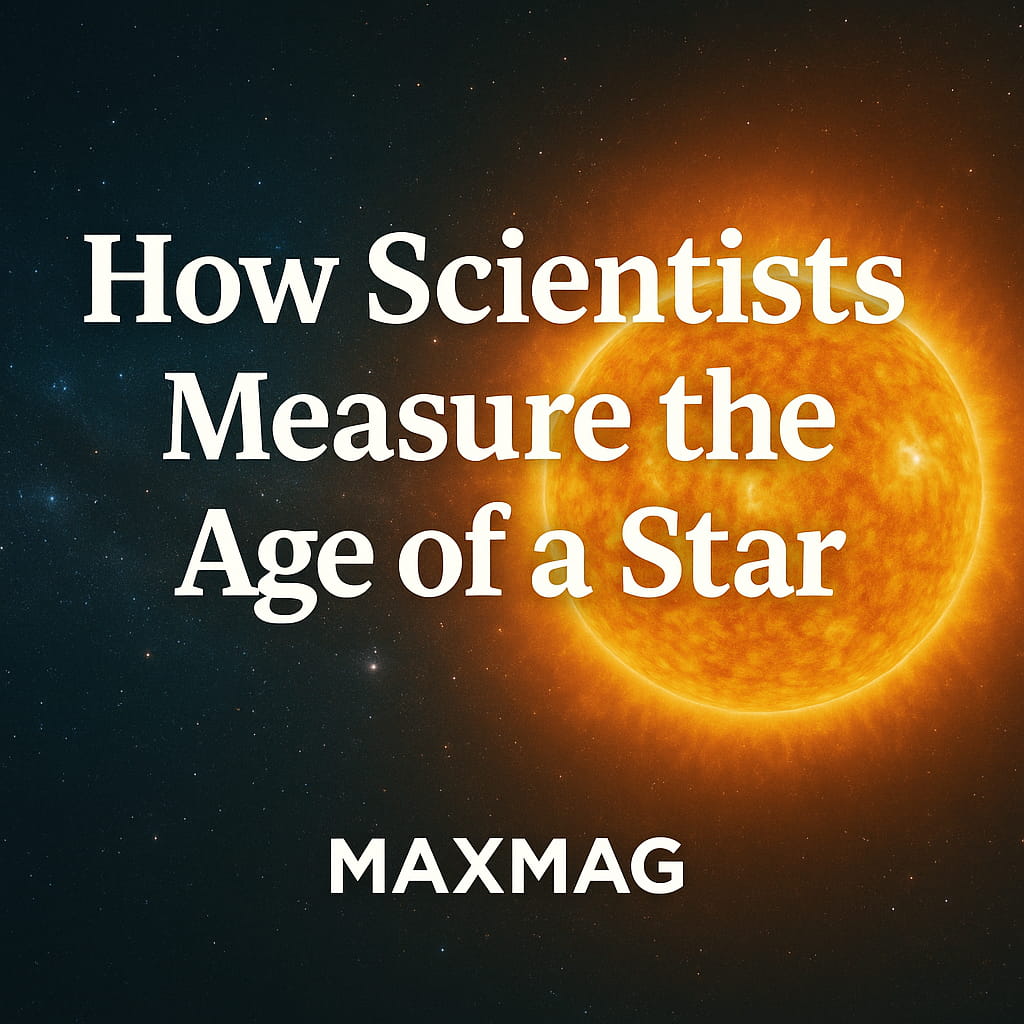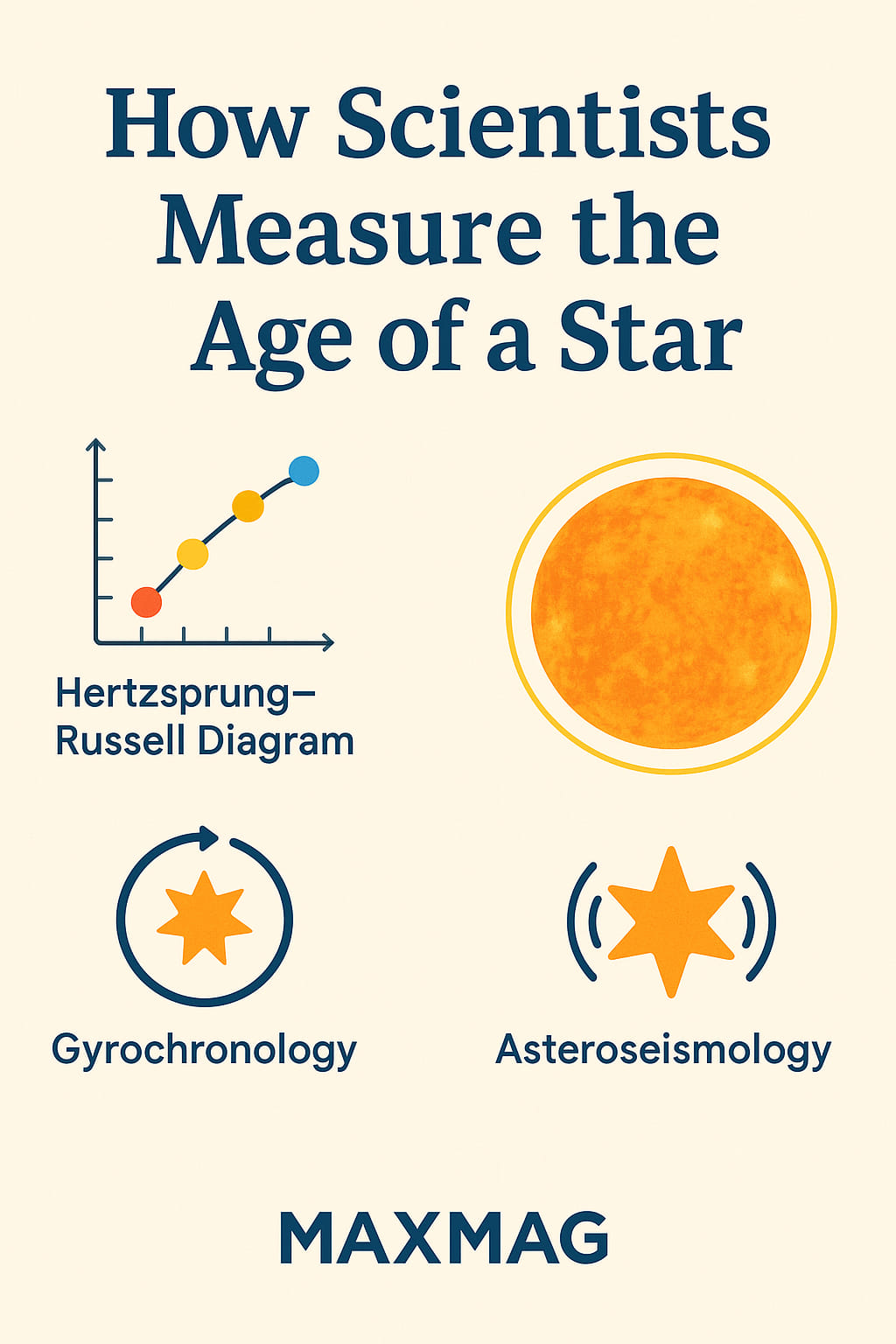
Unlike planets or people, stars don’t celebrate birthdays. They form quietly from clouds of gas and dust, ignite, and shine for billions of years before fading away. To trace their lifetimes, astronomers interpret the signs left in their glow — like historians deciphering the handwriting of light. As astrophysicist David Soderblom of the Space Telescope Science Institute once remarked, “The only star whose age we truly know is our Sun.” Every other estimate comes from careful detective work.
How scientists determine the age of a star
When scientists talk about the age of a star, they mean the time since it began fusing hydrogen at its core — the moment it officially switched on. Two stars can look alike in brightness and color yet sit at very different points in their life cycles. Understanding those ages helps researchers map stellar evolution, date star clusters, and predict our Sun’s long‑term future.
There isn’t one cosmic stopwatch. Instead, astronomers rely on a mosaic of methods — each measuring a different property: light and temperature on the Hertzsprung–Russell diagram, rotational slowdown via gyrochronology, and internal vibrations through asteroseismology. Each technique adds a clue, and together they reveal a portrait of time written in starlight.
The connection between the age of a star and its inner vibrations
If the HR diagram is a family photo and rotation is a ticking clock, asteroseismology is a stethoscope placed on a star’s heart. Stars pulsate subtly, their outer layers rippling from pressure waves that travel through their interiors. By studying those vibrations, astronomers infer what’s happening deep inside — density, composition, and the pace of nuclear fusion — and from there, the probable age of a star.
Space telescopes have transformed this approach. Kepler first recorded months‑long, rhythmic flickers in starlight; TESS continues the watch today. Those patterns correspond to pressure waves resonating through the star, and the frequencies act like fingerprints of its internal structure. For an entry point to this technique, NASA offers a comprehensive overview of vibration‑based stellar interior analysis on its public mission pages. NASA is credited here by name outside the link, per best practice for natural linking.
Reading the Hertzsprung–Russell diagram
One of the most enduring tools in astrophysics is the Hertzsprung–Russell diagram, which plots stars by temperature (color) and brightness. Most stars spend billions of years on the Main Sequence, steadily burning hydrogen. As their fuel wanes, they shift positions — swelling into red giants or ending as faint white dwarfs. By plotting a star’s place among these families, astronomers estimate its age relative to theoretical stellar evolution models.
Example: Imagine a star slightly brighter and hotter than the Sun. If its position matches what models predict for a three‑billion‑year‑old main‑sequence star, that’s its estimated age. When astronomers study entire clusters born at the same time, the HR diagram becomes a timeline: where stars peel off the Main Sequence marks the cluster’s formation date.
Rotation as a clock — gyrochronology
Every star spins, but not forever at the same pace. Magnetic fields and stellar winds act like brakes, gradually slowing rotation. This inspired gyrochronology, which links rotation rate to age. If two similar stars spin at different speeds, the slower one is usually older. The pattern holds best for young and middle‑aged stars; for ancient stars, the slowdown can plateau, so rotation alone won’t pin down the precise age of a star.
Example: If two solar‑type stars are otherwise alike yet one rotates twice as slowly, it’s roughly four times older, according to classic scaling. Combine that clue with HR placement and interior vibrations, and you get a cross‑checked estimate that’s far more trustworthy than any single method.
Cross‑checking the clocks
No method is perfect. The HR diagram provides a broad map; gyrochronology adds a time signal; asteroseismology delivers precision from within. When all three converge, confidence rises. Applying these models to our Sun confirms an age of a star at about 4.6 billion years — a benchmark that anchors many stellar models. When methods disagree, the mismatch often signals new physics: metallicity differences, magnetic slowdowns, or convection effects that theory must catch up to.

From the Sun to solar twins: practical examples
The Sun is astronomy’s yardstick. Because its interior, chemistry, and rotation are so well mapped, it serves as the reference for distant “solar twins.” If a faraway star shows a similar brightness and temperature but spins faster, it’s likely younger — perhaps a billion years old. If it spins more slowly and its vibration spectrum points to a helium‑enriched core, it’s an elder sibling well past midlife.
These comparisons do more than assign birthdays. They let researchers reconstruct when different generations of stars formed across the Milky Way, and by extension, when the galaxy produced the heavy elements needed for planets and life.
What’s next for stellar ages
The next decade looks like a golden era for measuring the age of a star. Europe’s PLATO mission will monitor thousands of targets continuously, blending light curves, rotational data, and vibration patterns into a single census. On the theory side, university groups are refining simulations that track magnetism, rotation, and chemical composition over billions of years. For a deeper dive into this line of work, Harvard maintains a research summary on advanced stellar modeling that situates current progress. Harvard is cited by name outside the link to keep brand mentions natural and the anchor text descriptive.
As observations grow sharper and models more realistic, astronomers won’t just estimate ages — they’ll explain the small discrepancies that once puzzled them. Each better‑dated star adds another pixel to our picture of how galaxies live, change, and seed the elements of life.
A reflection beyond numbers
There’s something undeniably human about our urge to measure the immeasurable. We date rocks, fossils, civilizations — and now, the light of suns we’ll never visit. The age of a star is more than a statistic; it’s a story about endurance, transformation, and time itself. The next time a point of light flickers overhead, remember: that glow began long before any eye existed to see it, and yet here we are, reading it like a diary written in photons.




